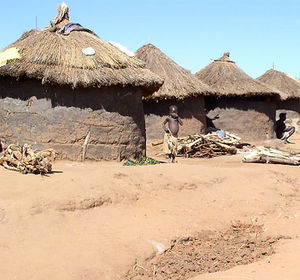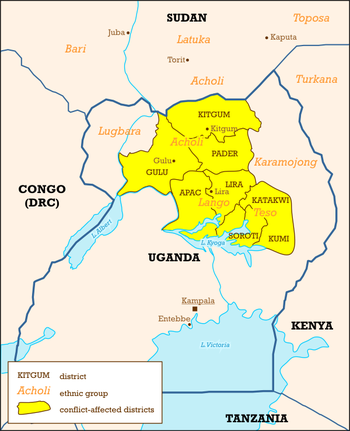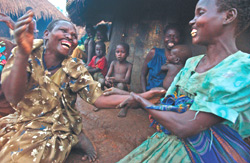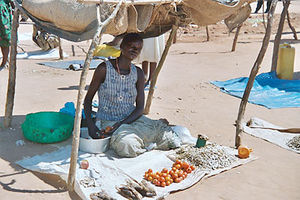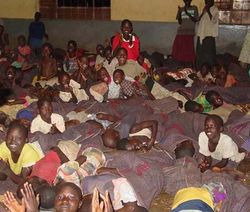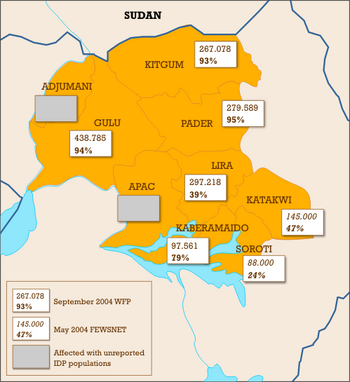Lord's Resistance Army
2007 Schools Wikipedia Selection. Related subjects: Conflict and Peace
SOS Children has Child Soldier Projects in Gulu, Uganda.
The Lord's Resistance Army (LRA), formed in 1987, is a rebel paramilitary group operating mainly in northern Uganda. The group is engaged in an armed rebellion against the Ugandan government in what is now one of Africa's longest-running conflicts. It is led by Joseph Kony, who proclaims himself a spirit medium, and apparently wishes to establish a state based on his unique interpretation of the Acholi religious syncretism and Biblical millenarianism. The LRA have been accused of widespread human rights violations, including mutilation, torture, rape, the abduction of civilians, the use of child soldiers and a number of massacres.
Background
The January 1986 overthrow of President Tito Okello, an ethnic Acholi, by the National Resistance Army (NRA) of southwest Ugandan Yoweri Museveni marked a period of intense turmoil. The Acholi feared the loss of their traditional dominance of the national military; they were also deeply concerned that the NRA would seek retribution for the brutal counterinsurgency, particularly the actions of the army in the Luwero triangle. By August of that year, a full-blown popular insurgency had developed in northern regions that were occupied by government forces.
Early history of the LRA (1987 to 1994)
In January 1987 Joseph Kony made his first appearance as a spirit medium, one of many who emerged after the initial success of the Holy Spirit Movement of Alice Auma. Former Uganda People's Democratic Army commander Odong Latek convinced Kony to adopt conventional guerrilla tactics, primarily surprise attacks on civilian targets, such as villages. The LRA also occasionally carried out large-scale attacks to underline the inability of the government to protect the populace. Until 1991 the LRA raided the populace for supplies, which were carried away by villagers who were abducted for short periods. The fact that some NRA units were known for their brutal actions ensured that the LRA were given at least passive support by segments of the Acholi population
March 1991 saw the start of "Operation North", which combined efforts to destroy the LRA while cutting away its roots of support among the population through heavy-handed tactics. As part of Operation North, Acholi Betty Oyella Bigombe, the Minister charged with ending the insurgency, created "Arrow Groups" mostly armed with bows and arrows, as a form of local defence. As the LRA was armed with modern weaponry, the bow-and-arrow groups were overpowered. Nevertheless, the creation of the Arrow Groups angered Kony, who began to feel that he no longer had the support of the population. In response the LRA mutilated numerous Acholi who they believed to be government supporters. While the government efforts were a failure, the LRA reaction caused many Acholi to finally turn against the insurgency. However, this was tempered by the deep-seated antagonism towards the occupying government forces.
After the failure of Operation North, Minister Bigombe initiated the first face-to-face meeting between representatives of the LRA and government. The LRA asked for a general amnesty for their combatants and stated that they would not surrender, but were willing to "return home." However, the government stance was hampered by disagreement over the credibility of the LRA negotiators and political infighting. In particular, the military had learned that Kony was negotiating with the Sudanese government for support while talking to Bigombe, and felt that Kony was simply trying to buy time. At a second meeting on 10 January 1994, Kony asked for six months to regroup his troops. By early February the tone of the negotiations was growing increasingly acrimonious, and following a meeting on 2 February, the LRA broke off negotiations stating that they felt that the NRA was trying to entrap them. Four days later, President Yoweri Museveni announced a seven-day deadline for the LRA to surrender. This ultimatum ended the Bigombe initiative.
An international conflict (1994 to 2002)
Two weeks after Museveni delivered his ultimatum of 6 February 1994, LRA fighters were reported to have crossed the northern border and established bases in southern Sudan with the approval of the Khartoum government. Sudanese aid was a response to Ugandan support for the rebel Sudan People's Liberation Army (SPLA) fighting in the civil war in the south of the country. Also, having become convinced that the Acholi were now collaborating with the Museveni government, Kony began to target the civilians using his increased military strength. Mutilations became commonplace, and 1994 saw the first mass forced abduction of children and young people. The most famous of these was the Aboke abductions of 139 female students in October 1996. As most of the LRA combatants are abducted children, a military solution is widely seen by the Acholi as a massacre of victims. Government attempts to destroy the rebels are thus viewed as another cause for grievance by the Acholi. The moral ambiguity of this situation, in which abducted young rebels are both the victims and perpetrators of brutal acts, is vital in understanding the current conflict.
The creation of government "protected villages" beginning in 1996 further deepened the antagonistic attitude that many Acholi have toward the government, especially as the population continues to be attacked by the LRA even within the "protected camps." The camps are also crowded, unsanitary, and miserable places to live. Meanwhile, in 1997 the Sudanese government of the National Islamic Front had begun to back away from its previous hard-line stance. Following the September 11, 2001 attacks in the U.S., the relationship between Sudan and Uganda abruptly changed. Cross-border tensions eased as support to proxy forces fell. Some of the hundreds of thousands of civilians displaced by the war began to return to their homes. The number of people displaced by the conflict declined to about half a million, and people began to talk openly of the day when the "protected camps" would be disbanded.
The insurgency flares (March 2002 to September 2005)
In March 2002, the UPDF launched a massive military offensive, named "Operation Iron Fist", against the LRA bases in southern Sudan with agreement from the National Islamic Front. This agreement, coupled with the return of Ugandan forces that had been deployed in the Democratic Republic of Congo upon the official end of the Second Congo War, created what the Ugandan government felt was an ideal situation in which to end a conflict that had become both an embarrassment and political liability. After several months of uncertainty, LRA forces began crossing back into Uganda and carrying out attacks on a scale and of a brutality not seen since 1995 to 1996, resulting in widespread displacement and suffering in regions that had never previously been touched by the insurgency.
A series of diplomatic initiatives during these years failed, especially as the exact negotiating position of Kony remained uncertain, but the conflict gained unprecedented international coverage. During a November 2003 field visit to Uganda, United Nations Undersecretary-General for Humanitarian Affairs and Emergency Relief Coordinator Jan Egeland stated, "I cannot find any other part of the world that is having an emergency on the scale of Uganda, that is getting such little international attention." In December 2003, Ugandan President Museveni referred the LRA to the International Criminal Court (ICC) to determine if the LRA is guilty of international war crimes.
From the middle of 2004 on, rebel activity dropped markedly under intense military pressure. The government was also the target of increasingly pointed criticism from the international community for its failure to end the conflict. International aid agencies have questioned the Ugandan government's reliance on military force and its commitment to a peaceful resolution. The army also admitted that it had recruited child soldiers who had escaped the LRA into the military.
In mid-September 2005, a band of LRA fighters, led by Vincent Otti, crossed into the Democratic Republic of the Congo (DRC) for the first time. President Museveni declared that, if Congolese authorities did not disarm the LRA combatants, the UPDF would be sent across the border in pursuit. This sparked a diplomatic row between the governments of the DRC and Uganda, with both militaries making a show of force along their border, while the Congolese ambassador to the United Nations sent a letter to the UN Secretary-General demanding that an economic embargo be placed on Uganda in retaliation.
Effects
The insurgency has been historically contained to the region known as Acholiland, consisting of the districts of Kitgum, Gulu, and Pader, though since 2002 violence has overflowed into other Ugandan districts. The LRA has also operated across the porous border region with Southern Sudan and most recently into the northeastern Ituri Province of the Democratic Republic of the Congo. The plight of the affected peoples has received little media coverage in the developed world. Not until April 2004 did the UN Security Council issue a formal condemnation. A 2005 poll of humanitarian professionals, media personalities, academics and activists identified the conflict in the north of Uganda as the second worst "forgotten" humanitarian emergency in the world, after the conflicts of the neighboring DRC.
The U.S. government estimates that up to 12,000 people have been killed in the violence, with many more dying from disease and malnutrition as a direct result of the conflict. Nearly two million civilians have been forced to flee their homes, living in internally displaced person (IDP) camps and within the safety of larger settlements, sleeping on street corners and in other public spaces.
| War violence experienced by abductees | |
|---|---|
| Witnessed a killing | 78% |
| Tied or locked up | 68% |
| Received a severe beating | 63% |
| Forced to steal or destroy property | 58% |
| Forced to abuse dead bodies | 23% |
| Forced to attack a stranger | 22% |
| Forced to kill a stranger | 20% |
| Forced to kill an opposing soldier in battle | 15% |
| Forced to attack a family member or friend | 14% |
| Forced to kill a family member or friend | 8% |
While many abductees are taken to carry items looted from raided villages, some are also used as soldiers and sex slaves. The group performs abductions primarily from the Acholi people, who have borne the brunt of the 18 year LRA campaign. The United Nations estimated in the mid-2000s that around 25,000 children have been kidnapped by the LRA since 1987. A 2006 survey of 750 youth in Kitgum and Pader concluded that the UN estimate was a significant underestimate. According to the survey, at least 66,000 youth between the ages of 13 and 30 have been abducted. One-third of all boys and one-sixth of all girls had been taken for at least one day. Of these, 66% of males were taken for longer than two weeks, while the equivalent number for females was 46%. If a female was gone for more than two weeks, there was a one in four chance that she had not returned. Males were again found to be taken for longer periods of time on average, with two in five males that were abducted for more than two weeks not having returned. The number of abductions was greatest in 2002 and 2003, perhaps in retaliation for Operation Iron Fist. However, the average age of abductees has risen from about 13 in 1994 to nearly 18 in 2004, coinciding with the rise in number, and fall in length, of abductions.
While the LRA now appears to consist of less than two thousand combatants that are under intense pressure from the Ugandan military, the government has been unable to end the insurgency so far. Ongoing peace negotiations have been complicated by an investigation by the International Criminal Court. The conflict continues to retard Uganda's development efforts, costing the poor country's economy a cumulative total of at least $1.33 billion, which is equivalent to 3% of GDP, or $100 million annually.
Night Commuters
Each night, children between the ages of 3 and 17, referred to as "Night Commuters" or "Night Dwellers" walk up to 20 kilometres (12 miles) from IDP camps to larger towns, especially Gulu, in search of safety.
Initiatives to raise international awareness for these children include the " Gulu Walks" and the work of the Uganda Conflict Action Network. Night commuters are also the subject of documentaries such as Stolen Children, Wardance, and Invisible Children.
The Invisible Children documentary sponsors the Global Night Commute, an event similar to Gulu Walks. Another program, The Name Campaign, asks people to wear nameplate necklaces imprinted with the first name of one of the thousands of abducted children as a means of raising public awareness. Danny Glover and Don Cheadle have both been vocal advocates on behalf of the children of Northern Uganda.
Latest developments
ICC arrest warrants
The International Criminal Court issued arrest warrants on 8 July and 27 September 2005 against Joseph Kony, his deputy Vincent Otti, and LRA commanders Raska Lukwiya, Okot Odiambo and Dominic Ongwen. The five LRA leaders are charged with crimes against humanity and war crimes, including murder, rape, sexual slavery, and enlisting of children as combatants. The warrants were filed under seal; public redacted versions were released on 13 October 2005. These were the first warrants issued by the ICC since it was established in 2002. Details of the warrants had been sent to the three countries where the LRA is active: Uganda, Sudan and Congo (DRC). The LRA leadership had long stated that they would never surrender unless they were granted immunity from prosecution, and the ICC order to arrest them seemed to guarantee that the insurgency would not have a negotiated end.
A group of LRA soldiers ambushed a team of humanitarian deminers from the Swiss Foundation for Mine Action (FSD) between Juba and Yei on 31 October 2005. Two deminers were killed, one Iraqi and one Sudanese. This follows a previous abduction of a FSD survey team on 13 September (in which the LRA did not kill anyone). OLS and UN Security gave a travel warning to all UN and non-UN agencies on 1 November 2005. The LRA then declared that it was deliberately targeting NGOs, and especially international staff members.
On 30 November 2005 LRA deputy commander, Vincent Otti, contacted the BBC announcing a renewed desire among the LRA leadership to hold peace talks with the Ugandan government. The government expressed skepticism regarding the overture but stated their openness to peaceful resolution of the conflict.
On 2 June 2006, Interpol issued five wanted person red notices to 184 countries on behalf of the ICC, which has no police of its own. Kony had been previously reported to have met Vice President of Southern Sudan Riek Machar. The next day, Human Rights Watch reported that the regional Government of Southern Sudan had ignored previous ICC warrants for the arrest of four of LRA's top leaders, and instead supplied the LRA with cash and food as an incentive to stop them from attacking southern Sudanese citizens.
Juba peace talks
|
|
|
HSM - Alice Auma |
|
1987-1994 |
|
Bibliography |
A series of ongoing meetings have been held in Juba since July 2006 between the government of Uganda and the LRA. The talks are mediated by Riek Machar, the Vice President of Southern Sudan, and by the Community of Sant'Egidio. The talks, which had resulted in a ceasefire by September 2006, have been either described as the best chance for a negotiated settlement ever or since the peace initiative of Betty Bigombe in 1994.
These talks were agreed to after Joseph Kony released a video in May in which he denied committing atrocities and seemed to call for an end to hostilities, in response to an announcement by Museveni that he would guarantee the safety of Kony if peace was agreed to by July. In late June 2006, the Government of Southern Sudan formally invited Uganda to attend peace talks , and on July 14, 2006 talks began in Juba. On 4 August 2006, Vincent Otti declared a unilateral ceasefire and asked the Ugandan government to reciprocate. ICC indictee Raska Lukwiya was killed in battle on 12 August 2006. Regardless, the government and LRA signed a truce on 26 August 2006. Under the terms of the agreement, LRA forces will leave Uganda and gather in two assembly areas, where the Ugandan government would not attack and the government of Southern Sudan guaranteed their safety. LRA rebels had begun gathering in the assembly areas by mid-September. Talks continued to be hindered by demands and counter-demands. Meanwhile, the government began a process of creating "satellite camps" to decongest the main IDP camps.
In broader context, the government of Southern Sudan views the talks as a means of ridding itself of a foreign army that is complicating their delicate relationship with the Khartoum government. The request by the Ugandan Government for ICC to suspend war crimes indictments against leaders of the LRA, condemned by international human rights groups but largely supported by leaders and civilians within northern Uganda, led some political analysts to see Ugandan Government's request as a ploy to gain local support.
